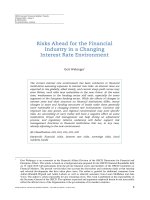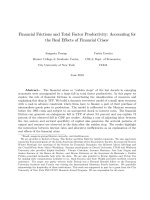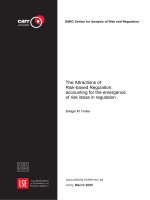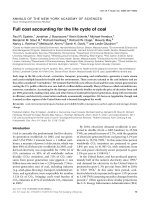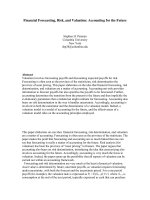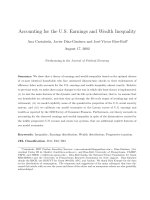Lecture Managerial Accounting for the hospitality industry: Chapter 9 - Dopson, Hayes
Bạn đang xem bản rút gọn của tài liệu. Xem và tải ngay bản đầy đủ của tài liệu tại đây (568.37 KB, 59 trang )
Chapter 9
Managerial Accounting
for Costs
© 2009 John Wiley & Sons
Hoboken, NJ 07030
1
Managerial Accounting for the Hospitality Industry
Dopson & Hayes
Chapter Outline
The Concept of Cost
Types of Costs
Cost/Volume/Profit Analysis
© 2009 John Wiley & Sons
Hoboken, NJ 07030
2
Managerial Accounting for the Hospitality Industry
Dopson & Hayes
Learning Outcomes
Identify the concept of a business cost.
Differentiate between the different types of business
costs.
Perform (when costs are known) a cost/volume/profit
analysis.
© 2009 John Wiley & Sons
Hoboken, NJ 07030
3
Managerial Accounting for the Hospitality Industry
Dopson & Hayes
The Concept of Cost
Given all the possible approaches to examining costs,
perhaps the easiest way to understand them is to
consider their impact on a businesses’ profit.
At any specific level of revenue, the lower a business’s
costs, the greater are its profits.
There are a variety of useful ways in which hospitality
managers and managerial accountants can view costs
and thus can better understand and operate their own
businesses.
© 2009 John Wiley & Sons
Hoboken, NJ 07030
4
Managerial Accounting for the Hospitality Industry
Dopson & Hayes
Types of Costs
Useful ways to classify business costs are:
Fixed and variable costs
Mixed costs
Step costs
Direct and indirect (overhead) costs
Controllable and non-controllable costs
Joint costs
Incremental costs
Standard costs
Sunk costs
Opportunity costs
© 2009 John Wiley & Sons
Hoboken, NJ 07030
5
Managerial Accounting for the Hospitality Industry
Dopson & Hayes
Types of Costs
Not all business costs can be objectively measured.
In fact, in some cases, costs can be a somewhat
subjective matter such as “talking with customers
regarding invoices”.
Cost accountants facing such issues can assign each
hospitality employee’s time to different activities
performed inside a company.
An accountant can then determine the total cost spent
on each activity by summing up the percentage of each
worker's time and pay that is spent on that activity.
© 2009 John Wiley & Sons
Hoboken, NJ 07030
6
Managerial Accounting for the Hospitality Industry
Dopson & Hayes
Types of Costs
This process is called activity based costing and it
seeks to assign objective costs to somewhat subjective
items such as the payment for various types of labor as
well as the even more subjective management tasks
involved with planning, organizing, directing and
controlling a hospitality business.
Using activity based costing to examine expenses and
thus better manage a business is called activity based
management and it is just one example of how fully
understanding costs can help you make better
decisions and operate a more successful business.
© 2009 John Wiley & Sons
Hoboken, NJ 07030
7
Managerial Accounting for the Hospitality Industry
Dopson & Hayes
Fixed and Variable Costs
As a manager, some of the costs you incur will stay the
same each month.
For that reason they are called fixed costs.
A fixed cost is one that remains constant despite
increases or decreases in sales volume (number of
guest or number of rooms).
Typical examples of fixed costs include payments for
insurance policies, property taxes, and management
salaries.
© 2009 John Wiley & Sons
Hoboken, NJ 07030
8
Managerial Accounting for the Hospitality Industry
Dopson & Hayes
Fixed and Variable Costs
A variable cost is one that increases as sales volume
increases and decreases as sales volume decreases.
Good managers seek to decrease their fixed costs to
their lowest practical levels while still satisfying the
needs of the business and its customers.
Those same good managers, however, know that
increases in variable costs are usually very good!
You would prefer, for example, to have to purchase
extra steaks and incur extra variable costs because that
would mean you sold more steaks and increased sales!
© 2009 John Wiley & Sons
Hoboken, NJ 07030
9
Managerial Accounting for the Hospitality Industry
Dopson & Hayes
g o fig u re!
To illustrate, consider Maureen’s Bountiful Burgers, a midsize, freestanding restaurant
outside a shopping mall, where Maureen features upscale gourmet burgers. If it costs
$2.00 of ingredients to make a gourmet burger and 50 guests order burgers, then the
total variable food cost is as follows:
Variable Cost per Guest (VC/Guest) x Number of Guests = Total Variable Cost
or
$2.00 x 50 = $100
If the total variable cost and the number of guests are known, VC/Guest can be
determined. Using basic algebra, a variation of the total variable cost formula can be
computed as follows:
Total Variable Cost
Number of Guests
= VC/Guest
or
$100
50
© 2009 John Wiley & Sons
Hoboken, NJ 07030
= $2.00
10
Managerial Accounting for the Hospitality Industry
Dopson & Hayes
Mixed Costs
It is clear that some business costs are fixed and that
some vary with sales volume (variable costs).
Still other types of cost contain a mixture of both fixed
and variable characteristics.
Costs of this type are known as semi-fixed, semivariable, or mixed costs.
In a hotel, the cost associated with a telephone system
is an excellent example of a mixed cost.
© 2009 John Wiley & Sons
Hoboken, NJ 07030
11
Managerial Accounting for the Hospitality Industry
Dopson & Hayes
Mixed Costs
The hotel will pay a monthly fee for the purchase price
repayment, or lease, of the actual phone system.
This represents a fixed cost because it will be the same
amount whether the occupancy percentage in the hotel
is very low or very high.
Increased occupancy, however, is likely to result in
increased telephone usage by guests.
A hotel’s local and long distance bill will increase as
additional hotel guests result in additional telephone
calls made.
© 2009 John Wiley & Sons
Hoboken, NJ 07030
12
Managerial Accounting for the Hospitality Industry
Dopson & Hayes
g o fig u re!
The best way to understand a mixed cost is to understand the mixed cost formula. To
illustrate, assume a hotel pays $4,000 per month to lease its telephone system. Assume
also that you know (from historical records) that the average guest staying at the hotel
makes one local and one long-distance telephone call. The cost, to the hotel, of each
call averages $0.50 in access fees, or a total of $1.00 per guest. Assume also that, in a
specific month, the hotel anticipates 7,500 guests. Using the following formula for mixed
costs, the hotel’s telephone bill for the month could be estimated as:
Fixed Cost + Variable Cost = Total Mixed Cost
or
Fixed Cost + (Variable Cost per Guest x Number of Guests) = Total Mixed Cost
or
$4,000 + ($1.00 x 7,500) = $11,500
© 2009 John Wiley & Sons
Hoboken, NJ 07030
13
Managerial Accounting for the Hospitality Industry
Dopson & Hayes
Separating Mixed Costs into
Variable and Fixed Components
A mixed cost can be divided into its fixed and variable
components in order for management to effectively
control the variable cost portion.
It is this variable cost that is the most controllable in the
short-term.
Several methods can be used to split mixed costs into
their fixed and variable components.
The most common methods are high/low, scatter
diagrams, and regression analysis.
© 2009 John Wiley & Sons
Hoboken, NJ 07030
14
Managerial Accounting for the Hospitality Industry
Dopson & Hayes
Separating Mixed Costs into
Variable and Fixed Components
Although regression analysis and scatter diagrams
provide more precise results, the high/low method is
easier to calculate and gives you a good estimate of the
variable and fixed components of a mixed cost.
Figure 9.4 shows costs for Joshua’s Restaurant.
In order to determine his variable costs and fixed costs
components for his restaurant, see Go Figure! following
Figure 9.4.
Figure 9.5 shows Joshua’s variable costs per guest and
fixed costs separated for his restaurant.
© 2009 John Wiley & Sons
Hoboken, NJ 07030
15
Managerial Accounting for the Hospitality Industry
Dopson & Hayes
Figure 9.4 Joshua’s Restaurant Costs for October, November, and December
NUMBER OF GUESTS
Food Cost
Beverage Cost
Salaries and Wages
Employee Benefits
Direct Operating Expenses
Music and Entertainment
Marketing
Utility Services
Repairs and Maintenance
Administrative and General
Occupancy
Depreciation
Interest
Total Costs
© 2009 John Wiley & Sons
Hoboken, NJ 07030
October
November
December
10,000
17,000
21,000
35,000
4,000
23,960
5,125
6,056
1,070
2,912
4,077
1,630
5,570
10,000
3,400
7,200
110,000
59,500
6,800
27,460
5,265
8,156
1,070
3,262
5,477
1,840
5,570
10,000
3,400
7,200
145,000
73,500
8,400
29,460
5,345
9,356
1,070
3,462
6,277
1,960
5,570
10,000
3,400
7,200
165,000
16
Managerial Accounting for the Hospitality Industry
Dopson & Hayes
g o fig u re!
To demonstrate how the high/low method separates a mixed cost into its variable and
fixed components, we will use Joshua’s marketing expense from Figure 9.4. The
high/low method uses the three following steps:
1. Determine variable cost per guest for the mixed cost.
Choose a high volume month (December) and a low volume month (October) that
represents normal operations. Then, use the following formula to separate out
variable cost per guest for the mixed cost:
High Cost – Low Cost
High # of Guests – Low # of Guests
= Variable Cost per Guest (VC/Guest)
or
$3,462 - $2,912
21,000 – 10,000
= $0.05
2. Determine total variable costs for the mixed cost.
Multiply variable cost per guest by either the high or low volume (number of guests)
as follows:
VC/Guest x Number of Guests = Total Variable Cost
or
$0.05 x 10,000 = $500
© 2009 John Wiley & Sons
Hoboken, NJ 07030
17
Managerial Accounting for the Hospitality Industry
Dopson & Hayes
( g o fig u re! continued)
3. Determine the fixed costs portion of the mixed cost.
Subtract total variable cost from the mixed cost (at the high volume or low volume
you chose in step 2 – low volume at 10,000 guests was chosen in this example) to
determine the fixed cost portion as follows.
Mixed Cost – Total Variable Cost = Fixed Cost
or
$2,912 - $500 = $2,412
Thus, Joshua’s mixed marketing expense can be shown with its variable and fixed
components as follows:
Fixed Cost + Variable Cost = Total Mixed Cost
or
Fixed Cost + (Variable Cost per Guest x Number of Guests) = Total Mixed Cost
or
At 10,000 guests served:
$2,412 + ($0.05 x 10,000) = $2,912
© 2009 John Wiley & Sons
Hoboken, NJ 07030
18
Managerial Accounting for the Hospitality Industry
Dopson & Hayes
Figure 9.5 Joshua’s Restaurant Variable Costs per Guest and Fixed Costs
NUMBER OF GUESTS
Food Cost
Beverage Cost
Salaries and Wages
Employee Benefits
Direct Operating
Expenses
Music and Entertainment
Marketing
Utility Services
Repairs and
Maintenance
Administrative and
General
Occupancy
Depreciation
Interest
Total Costs
© 2009 John Wiley & Sons
Hoboken, NJ 07030
October November December
10,000
17,000
21,000
Variable
Cost per
Guest
Fixed
Costs
35,000
4,000
23,960
5,125
59,500
6,800
27,460
5,265
73,500
8,400
29,460
5,345
3.50
0.40
0.50
0.02
0
0
18,960
4,925
6,056
1,070
2,912
4,077
8,156
1,070
3,262
5,477
9,356
1,070
3,462
6,277
0.30
0
0.05
0.20
3,056
1,070
2,412
2,077
1,630
1,840
1,960
0.03
1,330
5,570
10,000
3,400
7,200
110,000
5,570
10,000
3,400
7,200
145,000
5,570
10,000
3,400
7,200
165,000
0
0
0
0
$5.00
5,570
10,000
3,400
7,200
$60,000
19
Managerial Accounting for the Hospitality Industry
Dopson & Hayes
Total Costs
As you can see in Figure 9.5, total fixed costs and total
variable costs per guest are the same for all levels of
number of guests served.
Total costs are mixed costs, and thus can be treated as
such.
The total cost equation represents a straight line as
shown in Figure 9.6.
See the Go Figure! exercise following Figure 9.6 for
application of the Total Cost Equation.
© 2009 John Wiley & Sons
Hoboken, NJ 07030
20
Managerial Accounting for the Hospitality Industry
Dopson & Hayes
Figure 9.6 Total Cost Graph
y axis
Total Cost
VC/Guest
Dollars
Fixed Cost
0
Low
© 2009 John Wiley & Sons
Hoboken, NJ 07030
Sales (volume)
21
High
x axis
Managerial Accounting for the Hospitality Industry
Dopson & Hayes
g o fig u re!
As you may remember from high school algebra, the equation for a line is y = a + bx.
The equation for a line applies to the Total Cost line, where “a” is the y intercept (fixed
costs), “b” is the slope of the line (VC/Guest), “x” is the independent variable (Number of
Guests or Sales Volume), and “y” is the dependent variable (Total Cost). The total cost
equation can be summarized as follows for Joshua’s Restaurant:
Total Cost Equation
y = a + bx
or
Total Costs = Fixed Costs + (Variable Cost per Guest x Number of Guests)
or
At any number of guests served at Joshua’s Restaurant:
Total Costs = $60,000 + ($5.00 x Number of Guests)
Thus, assuming that in a normal month variable costs per guest and fixed costs remain
the same for Joshua’s restaurant, total costs in any month can be estimated by using the
Total Cost Equation. All Joshua must do is insert the anticipated number of guests into
the equation to estimate total costs for any month. For example, if Joshua expects the
month of June to have 18,000 guests, he can estimate his total costs as follows:
Total Costs = Fixed Costs + (Variable Cost per Guest x Number of Guests)
or
At 18,000 guests served:
$150,000 = $60,000 + ($5.00 x 18,000)
© 2009 John Wiley & Sons
Hoboken, NJ 07030
22
Managerial Accounting for the Hospitality Industry
Dopson & Hayes
Total Costs
Total fixed costs and total variable costs per guest are
the same for all levels of number of guests served.
Therefore, managers can predict total costs at varying
levels of guests based on the total cost equation.
Effective managers know they should not categorize
fixed, variable, or mixed costs in terms of being either
"good" or "bad".
Some costs are, by their very nature, related to sales
volume. Others are not.
The goal of management is not to reduce, but to
increase total variable costs in direct relation to
increases in total sales volume.
© 2009 John Wiley & Sons
Hoboken, NJ 07030
23
Managerial Accounting for the Hospitality Industry
Dopson & Hayes
Step Costs
A step cost is a cost that increases as a range of activity
increases or as a capacity limit is reached.
That is, instead of increasing in a linear fashion like
variable costs, step cost increases look more like a
staircase (hence the name “step” costs).
For example, if one well-trained server can effectively
provide service for a range of 1 to 30 of a restaurant’s
guests, and 40 guests are anticipated, a second server
must be scheduled.
Each additional server added increases the restaurants
costs in a non-liner (step-like) fashion.
© 2009 John Wiley & Sons
Hoboken, NJ 07030
24
Managerial Accounting for the Hospitality Industry
Dopson & Hayes
Figure 9.7 Step Costs
Server 3
Cost
Server 2
Server 1
1-30
31-60
61-90
Volume
© 2009 John Wiley & Sons
Hoboken, NJ 07030
25
Managerial Accounting for the Hospitality Industry
Dopson & Hayes

